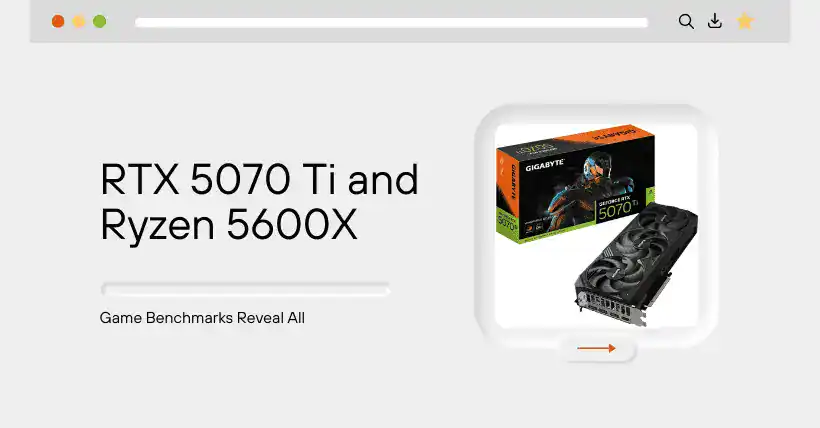01
Introduction
At present, NVIDIA’s RTX 50 series graphics cards have been released and are available on the market, becoming a top choice for many users looking to build new systems. However, a significant number of users are still using older platforms (such as the AM4 platform) and have no plans to switch platforms in the short term. These users are interested in upgrading GPU performance individually and are considering purchasing an RTX 50 series graphics card.
The Ryzen 5 5600X is a classic older processor that is still actively used in many primary systems. This article will test the gaming performance of the Ryzen 5 5600X + RTX 5070 Ti configuration to evaluate whether there is any performance bottleneck in this pairing, providing a reference for interested users.
02
Test Platform Configuration
The main configuration is as follows:
CPU: Ryzen 5 5600X
Motherboard: Gigabyte AORUS Master B550
Memory: 32GB DDR4 3600MHz
GPU: GeForce RTX 5070 Ti
SSD: ADATA 1TB GAMMIX S70 Blade
Operating System: Windows 10
03
Game Tests (RTX 5070 Ti and Ryzen 5600X)
Seven games were tested, all at 1080P resolution settings.
Game 1: God of War
- Average FPS: 109
- 1% Low FPS: 78
- Frame Time: 7.7ms
- CPU Usage: 52%, Power: 76W, Temp: 67°C
- RAM Usage: 13.1GB
- GPU Usage: 97%, VRAM Usage: 6.5GB, Power: 237W, Temp: 58°C
CPU usage was moderate at around 50%, RAM usage around 13GB, and GPU utilization nearly maxed out. VRAM usage ranged between 6–7GB. With an average FPS over 100 and minimum FPS above 70, performance was very smooth, and the GPU was fully utilized with no bottleneck.
Game 2: Spider-Man 2
- Average FPS: 71
- 1% Low FPS: 47
- Frame Time: 15.2ms
- CPU Usage: 74%, Power: 77W, Temp: 63°C
- RAM Usage: 12.7GB
- GPU Usage: 61%, VRAM Usage: 9.7GB, Power: 119W, Temp: 43°C
CPU usage exceeded 70%, while GPU utilization was only around 60%. RAM usage was between 12–13GB, and VRAM usage between 9–10GB. Performance was fairly smooth, but the GPU was underutilized due to higher CPU load.
Game 3: Cyberpunk 2077
- Average FPS: 59
- 1% Low FPS: 41
- Frame Time: 16.5ms
- CPU Usage: 87%, Power: 78W, Temp: 66°C
- RAM Usage: 10.3GB
- GPU Usage: 68%, VRAM Usage: 9.7GB, Power: 198W, Temp: 51°C
CPU usage was very high, nearly 90%, and GPU utilization was around 70%. RAM usage was just over 10GB. Average FPS exceeded 50 with smooth performance, but the high CPU load limited full GPU performance.
Game 4: S.T.A.L.K.E.R. 2
- Average FPS: 52
- 1% Low FPS: 33
- Frame Time: 17.2ms
- CPU Usage: 71%, Power: 78W, Temp: 66°C
- RAM Usage: 16.6GB
- GPU Usage: 58%, VRAM Usage: 7.4GB, Power: 139W, Temp: 48°C
CPU load was over 70%, with RAM usage between 16–17GB. GPU utilization hovered around 60%, with VRAM usage just above 7GB. Performance was basically smooth, but the CPU bottleneck prevented full GPU utilization.
Game 5: Monster Hunter Wilds
- Average FPS: 64
- 1% Low FPS: 29
- Frame Time: 16.7ms
- CPU Usage: 77%, Power: 77W, Temp: 68°C
- RAM Usage: 15.8GB
- GPU Usage: 74%, VRAM Usage: 13.7GB, Power: 150W, Temp: 51°C
CPU load was relatively high (70–80%), with RAM usage around 15–16GB. GPU utilization was slightly above 70%, with VRAM usage between 13–14GB. Performance was fairly smooth but again limited by CPU load.
Game 6: Black Myth: Wukong
- Average FPS: 82
- 1% Low FPS: 52
- Frame Time: 9.5ms
- CPU Usage: 47%, Power: 76W, Temp: 67°C
- RAM Usage: 14.6GB
- GPU Usage: 98%, VRAM Usage: 7.6GB, Power: 221W, Temp: 57°C
CPU usage was around 50%, RAM usage around 14–15GB. GPU utilization was nearly maxed out, and VRAM usage ranged between 7–8GB. With an average FPS over 80 and low FPS above 50, the performance was very smooth and the GPU was fully utilized with no bottleneck.
Game 7: The Last of Us Part I
- Average FPS: 89
- 1% Low FPS: 53
- Frame Time: 7.4ms
- CPU Usage: 94%, Power: 78W, Temp: 64°C
- RAM Usage: 14.4GB
- GPU Usage: 74%, VRAM Usage: 9.7GB, Power: 141W, Temp: 47°C
CPU usage was extremely high at over 90%, while GPU utilization was just above 70%. RAM usage was 14–15GB, VRAM usage 9–10GB. Although performance was smooth, high CPU load limited the GPU’s performance potential.
04
Conclusion
The test results are clear: for the Ryzen 5 5600X + GeForce RTX 5070 Ti configuration, in most games the RTX 5070 Ti cannot run at full performance, with evident bottlenecks.
The final conclusion: the Ryzen 5 5600X + GeForce RTX 5070 Ti setup has a performance bottleneck. If you are still using the Ryzen 5 5600X and intend to upgrade your graphics card, it is not recommended to opt for models more powerful than the GeForce RTX 5070 Ti.

Disclaimer:
- This channel does not make any representations or warranties regarding the availability, accuracy, timeliness, effectiveness, or completeness of any information posted. It hereby disclaims any liability or consequences arising from the use of the information.
- This channel is non-commercial and non-profit. The re-posted content does not signify endorsement of its views or responsibility for its authenticity. It does not intend to constitute any other guidance. This channel is not liable for any inaccuracies or errors in the re-posted or published information, directly or indirectly.
- Some data, materials, text, images, etc., used in this channel are sourced from the internet, and all reposts are duly credited to their sources. If you discover any work that infringes on your intellectual property rights or personal legal interests, please contact us, and we will promptly modify or remove it.



